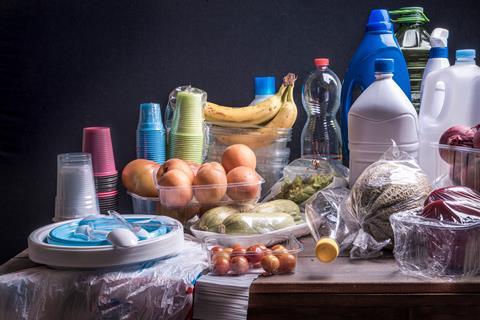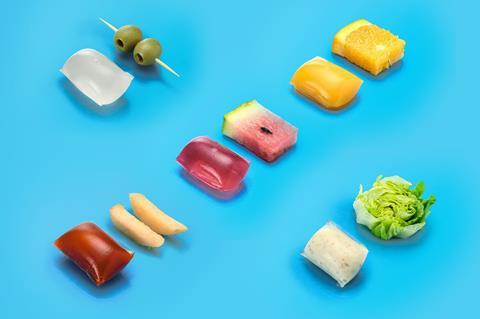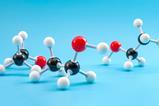The new technologies helping to reduce food and wrapper waste

Today’s consumers are painfully aware of the need to reduce food and packaging waste. Industry has come up with novel ways to achieve this goal, from active materials that keep food fresh, to sensors that reveal when food is starting to spoil or when packaging is damaged.
The most significant, recent food packaging innovations involve nanotechnology, says Emma Bradley, an analytical chemist at Fera in York, the UK national reference laboratory for food contact materials. Officially defined as having a diameter below 100 nanometres, nanoparticles have unique properties that provide stronger, antimicrobial (active) packaging. Plastics with embedded nanoparticles are already used for some beer bottles, enhancing shelf life by up to six months.
In your class
Food packaging is something we all take for granted and our students hardly notice it in their day-to-day lives. This article describes recent innovations in the fight to reduce food and packaging waste. It provides excellent background information that will give context to lessons on topics including polymers and redox chemistry. The accompanying lesson activity develops skills in reading for a purpose and organising information.
Silver nanoparticles have better antimicrobial properties than metallic silver, thanks to their extremely large surface area, which increases contact with the microorganisms they are fighting. The nanoparticles are mostly embedded in traditional plastic packaging, but it is possible to add them to biodegradable films, such as those made from starch.
The food packing industry is also eyeing up zinc oxide nanoparticles, normally used in sun cream, which absorb UV light. They penetrate microbial cells and generate reactive oxygen species that damage key cell components, and UV light increases their activity. Zinc oxide nanoparticles have been incorporated into different materials, including glass and low-density polyethylene.
The packaging is highly effective but levels of nanoparticles entering food need to be kept below safe thresholds because of concerns over potential adverse effects in humans.

Pod potential
Bioplastic polymers are billed as a great way to reduce plastic waste. Skipping Rocks Lab, a London-based start-up, has developed ‘edible water bottles’ made from seaweed and plants. It creates pods, named Ooho, by dipping frozen liquid balls in a seaweed mixture to form a long-lasting, tasteless membrane around them. The pods can be eaten whole or bitten into to release their contents, which range from ginger juice to take-away ketchup. Discarded capsules will naturally decompose in four to six weeks, just like fruit.
Skipping Rocks Lab’s membrane technology, Notpla, can also be used as a water- and greaseproof coating on cardboard packaging. The company markets the fact that seaweed doesn’t need fresh water or fertiliser and doesn’t compete with food crops. They are currently developing netting bags for fresh produce, such as oranges.
Consumer demand is leading to a host of bioplastic food packaging entering the market. Like conventional plastics, they are made from polymers. The only difference is that the polymers are derived from plants rather than fossil fuels and are generally biodegradable. A Fera report for the UK Food Standards Agency found that the bio-based materials have similar properties to traditional oil-based plastics.
Download this
Information organiser, for age range 11–16
In this activity students use the information in the article to produce a graphic organiser. Constructing and using graphic organisers is a useful study skill. The activity can be used as a separate study skills lesson or homework exercise, as well as in lessons on specific topics.
Download the graphic organiser activity, teacher notes and this article text from the Education in Chemistry website: rsc.li/35udsWt
In this activity students use the information in the article to produce a graphic organiser. Constructing and using graphic organisers is a useful study skill. The activity can be used as a separate study skills lesson or homework exercise, as well as in lessons on specific topics.
Download the graphic organiser activity as MS Word or pdf, the teacher notes as MS Word or pdf, an example as pdf and the article text as pdf.
So far, so good, but manufacturers need to watch for migration of chemicals from packaging into foods. Materials such as paper and board have been well studied, but there is limited information on other types of bio-based food contact materials. ‘Not all of these materials are as good as advertised,’ says Thomas Simat, chair for food chemistry and food and skin contact materials at the Technical University Dresden, Germany.
Fera also points to a dramatic increase in the use of bamboo in items such as reusable cups, marketed as green alternatives and available in many shops. But often the bamboo is simply added to a traditional melamine plastic. ‘There are lots of products labelled as bamboo, but in most cases these are plastics and in some cases the migration [into foods] that takes place is above legal limits,’ says Emma.
Smart solutions
If safety can be demonstrated, then bio-based ‘intelligent’ food packaging may be just the ticket. Intelligent or smart packaging is designed to sense biochemical or microbial changes in food to show when it is starting to go off.
Oxygen is one of the main causes of food degradation because it boosts microbe growth and oxidises fats. Many fresh foods have modified atmosphere packaging (MAP), with reduced oxygen levels and higher levels of gases such as carbon dioxide and nitrogen. A problem with MAP is the lack of a simple, inexpensive oxygen indicator to show if the packaging is leaking. Spanish plastics technology centre AIMPLAS recently launched a project to develop a printed sensor that changes colour in the presence of oxygen, highlighting defects in MAP.
Another way to check if food is going off is to detect the gases released by food-spoiling microorganisms, for example carbon dioxide and hydrogen sulfide. ‘Freshness indicators’ consist of substances that change colour in the presence of selected chemicals. Researchers from China and the UK have made a meat freshness indicator using gellan, a natural gum, combined with silver nanoparticles. The system detects hydrogen sulfide produced when meat starts to go off. Silver sulfide is formed, which causes a visible colour change from yellow to colourless.
Researchers have already developed low-cost green, active and intelligent packaging solutions. Once regulators and industry are ready to approve and adopt them, food and packaging waste could be a thing of the past.
Article by Emma Davies, a science writer. Resource by Kristy Turner, a science teacher fellow at University of Manchester and Bolton School
Recommended resources
- For more information on packaging, read What a waste and try the accompanying activities
- Challenge students aged 14–16 to use their problem-solving skills to complete these puzzles on the topic of polymers
- In this practical activity for students aged 14-16 explore the properties of a polymer derived from seaweed
- Packaging can serve a purpose such as providing use-by dates or allergy information; find out about the role of a development chemist making inks for packaging
- For more information on packaging, read the article, ‘What a waste ’ and try the accompanying activities: rsc.li/2ZnckzY
- Challenge students aged 14–16 to use their problem-solving skills to complete these puzzles on the topic of polymers: rsc.li/3if8nVq
- In this practical activity for students aged 14-16 explore the properties of a polymer derived from seaweed: rsc.li/3jYXFCT



















No comments yet